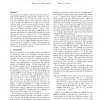Free Online Productivity Tools
i2Speak
i2Symbol
i2OCR
iTex2Img
iWeb2Print
iWeb2Shot
i2Type
iPdf2Split
iPdf2Merge
i2Bopomofo
i2Arabic
i2Style
i2Image
i2PDF
iLatex2Rtf
Sci2ools
CCCG
2010
2010
New variations of the reverse facility location problem
In this paper we consider a natural extension of the socalled reverse facility location problem which was introduced by Cabello et al. [3]. Given a set of n users and a set of m facilities, where a user takes service from its nearest facility, the objective is to place two new facilities such that the total number of users served by these two new facilities is maximized. We refer to this problem as the 2-MaxCov problem. In the L1 and L metrics, the worst case time and space complexities of our proposed algorithm for solving this problem are both O(n2 log n). In the L2 metric, if m = 1, the 2-MaxCov problem can be solved easily in O(n) time. We have also considered the obnoxious version of this problem, referred to as the 2-Farthest-MaxCov problem, where a user is served by its farthest facility. Our proposed algorithm for this problem runs in O(n log n) time for all the considered distance measures.
| Added | 29 Oct 2010 |
| Updated | 29 Oct 2010 |
| Type | Conference |
| Year | 2010 |
| Where | CCCG |
| Authors | Bhaswar B. Bhattacharya, Subhas C. Nandy |
Comments (0)

